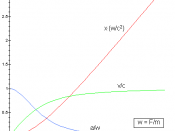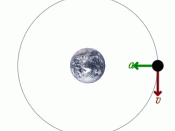1. The first law deals with forces and changes in velocity. It states that, if an object is moving it will continue to move at the same velocity unless another force acts on it. If an object is motionless it will remain motionless unless another force acts on it.
Examples:
Car Collisions - When a car hits a tree the 1st collision is the car hitting a tree, second collision is any loose object continuing in motion and hitting the windshield.
When you ride in a car, and you suddenly turn around a corner, you get thrown to the side. That is because you move in one direction, and the car changes direction, but you still want to go the direction you were already moving.
2. Newton's second law of motion explains how an object will change velocity if it is pushed or pulled upon.
* Firstly, this law states that if you do place a force on an object, it will accelerate, i.e.,
change its velocity, and it will change its velocity in the direction of the force.
* Secondly, this acceleration is directly proportional to the force. For example, if you are pushing on an object, causing it to accelerate, and then you push, three times harder, the acceleration will be three times greater.
* Thirdly, this acceleration is inversely proportional to the mass of the object. For example, if you are pushing equally on two objects, and one of the objects has five times more mass than the other, it will accelerate at one fifth the acceleration of the other.
3. The third law states that for every force there is an equal and opposite force. For example, if you push on a wall, it will push back on you as hard as you are pushing on...
![English: A free-falling object achieves its terminal velocity when the downward force of gravity (Fg) equals the upward force of drag (Fd). This causes the net force on the object to be zero, resulting in an acceleration of zero.[1]](https://s.writework.com/uploads/1/14591/english-free-falling-object-achieves-its-terminal-velocity-d-thumb.gif)

